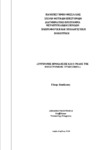On the action of the anti-absence drug ethosuximide in the rat and cat thalamus
| dc.creator | Leresche, N. | en |
| dc.creator | Parri, H. R. | en |
| dc.creator | Erdemli, G. | en |
| dc.creator | Guyon, A. | en |
| dc.creator | Turner, J. P. | en |
| dc.creator | Williams, S. R. | en |
| dc.creator | Asprodini, E. | en |
| dc.creator | Crunelli, V. | en |
| dc.date.accessioned | 2015-11-23T10:37:40Z | |
| dc.date.available | 2015-11-23T10:37:40Z | |
| dc.date.issued | 1998 | |
| dc.identifier.issn | 2706474 | |
| dc.identifier.uri | http://hdl.handle.net/11615/30261 | |
| dc.description.abstract | The action of ethosuximide (ETX) on Na+, K+, and Ca2+ currents and on tonic and burst-firing patterns was investigated in rat and cat thalamic neurons in vitro by using patch and sharp microelectrode recordings. In thalamocortical (TC) neurons of the rat dorsal lateral geniculate nucleus (LGN), ETX (0.75-1 mM) decreased the noninactivating Na+ current, I(NAP), by 60% but had no effect on the transient Na+ current. In TC neurons of the rat and cat LGN, the whole-cell transient outward current was not affected by ETX (up to 1 mM), but the sustained outward current was decreased by 39% at 20 mV in the presence of ETX (0.25-0.5 mM): this reduction was not observed in a low Ca2+ (0.5 mM) and high Mg2+ (8 mM) medium or in the presence of Ni2+ (1 mM) and Cd2+ (100 μM). In addition, ETX (up to I mM) had no effect on the low-threshold Ca2+ current, I(T), of TC neurons of the rat ventrobasal (VB) thalamus and LGN and in neurons of the rat nucleus reticularis thalami nor on the highthreshold Ca2+ current in TC neurons of the rat LGN. Sharp microelectrode recordings in TC neurons of the rat and cat LGN and VB showed that ETX did not change the resting membrane potential but increased the apparent input resistance at potentials greater than -60 mV, resulting in an increase in tonic firing. In contrast, ETX decreased the number of action potentials in the burst evoked by a low-threshold Ca2+ potential. The frequency of the remaining action potentials in a burst also was decreased, whereas the latency of the first action potential was increased. Similar effects were observed on the burst firing evoked during intrinsic 8 oscillations. These results indicate an action of ETX on I(NaP) and on the Ca2+-activated K+ current, which explains the decrease in burst firing and the increase in tonic firing, and, together with the lack of action on low- and high-threshold Ca2+ currents, the results cast doubts on the hypothesis that a reduction of IT in thalamic neurons underlies the therapeutic action of this anti-absence medicine. | en |
| dc.source.uri | http://www.scopus.com/inward/record.url?eid=2-s2.0-0032125478&partnerID=40&md5=9c1415f37c5fd93665c01b33ec7d1161 | |
| dc.subject | Absence epilepsy | en |
| dc.subject | Burst firing | en |
| dc.subject | Ca2+ currents | en |
| dc.subject | Ethosuxirnide | en |
| dc.subject | K+ currents | en |
| dc.subject | Na+ currents | en |
| dc.subject | Thalamus | en |
| dc.subject | Tonic firing | en |
| dc.subject | cadmium | en |
| dc.subject | calcium ion | en |
| dc.subject | ethosuximide | en |
| dc.subject | magnesium | en |
| dc.subject | potassium ion | en |
| dc.subject | sodium ion | en |
| dc.subject | absence | en |
| dc.subject | action potential | en |
| dc.subject | animal cell | en |
| dc.subject | animal tissue | en |
| dc.subject | article | en |
| dc.subject | calcium current | en |
| dc.subject | cat | en |
| dc.subject | controlled study | en |
| dc.subject | drug mechanism | en |
| dc.subject | lateral geniculate nucleus | en |
| dc.subject | nonhuman | en |
| dc.subject | potassium current | en |
| dc.subject | priority journal | en |
| dc.subject | rat | en |
| dc.subject | sodium current | en |
| dc.subject | Action Potentials | en |
| dc.subject | Animals | en |
| dc.subject | Anticonvulsants | en |
| dc.subject | Baclofen | en |
| dc.subject | Calcium Channels | en |
| dc.subject | Cats | en |
| dc.subject | Epilepsy, Absence | en |
| dc.subject | GABA Agonists | en |
| dc.subject | Geniculate Bodies | en |
| dc.subject | Neurons | en |
| dc.subject | Patch-Clamp Techniques | en |
| dc.subject | Potassium | en |
| dc.subject | Potassium Channels | en |
| dc.subject | Rats | en |
| dc.subject | Rats, Sprague-Dawley | en |
| dc.subject | Rats, Wistar | en |
| dc.subject | Sodium | en |
| dc.subject | Sodium Channels | en |
| dc.title | On the action of the anti-absence drug ethosuximide in the rat and cat thalamus | en |
| dc.type | journalArticle | en |
Files in this item
| Files | Size | Format | View |
|---|---|---|---|
|
There are no files associated with this item. |
|||


